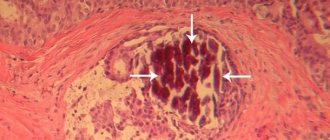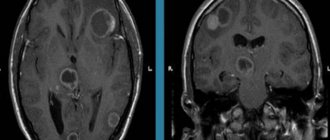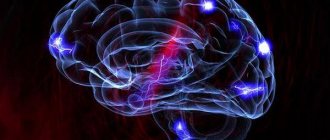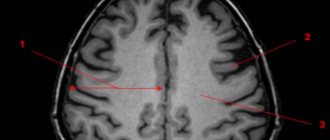The diagnosis of dyscirculatory encephalopathy or chronic cerebral ischemia, as it is also called, sounds scary. But what is it and why is it developing?
For our brain to function normally, it must receive adequate nutrition every day.
Our brain is fed by vessels - arteries, which bring to the brain all the necessary amino acids, vitamins, vitamin-like substances, minerals, biologically active substances, oxygen and much more. And the veins carry all the “processed products” out of the brain. When, for one reason or another, the brain “does not get enough food” or is overfilled with “waste” products, discirculatory encephalopathy , in other words, it is the suffering of the brain from improper blood supply and nutrition.
A number of factors aggravate the course and stimulate the progression of dyscirculatory encephalopathy:
- Acute and/or chronic psycho-emotional stress (stressful work, stressful situation in the family, sleep disturbance, night work, daily work without rest, work in extreme conditions). Stress triggers a destructive cascade leading to cerebral vasospasm and poor blood supply, as a result of which various biochemical processes in nerve cells are disrupted
- Hypokinesia (lack of daily dosed physical activity, lack of daily walks in the fresh air, sedentary work). For normal functioning of the cardiovascular system, it is recommended to engage in any dosed physical activity every day (!) for an hour. But this is not house cleaning work, this is not work in the country house/garden. This could be walking, cycling, swimming, dancing, any cardio training, yoga, or sports games. Such loads stimulate blood flow throughout the body and in the brain.
- Overweight and obesity . Absolutely every obese person sooner or a little later develops arterial hypertension and atherosclerotic changes in the blood vessels of the brain. Atherosclerosis was once thought to be a disease of old age. But it has long been known that atherosclerotic lesions of the aorta develop even in infants. And more and more often we see atherosclerotic changes in cerebral vessels by the age of 30. And, as a rule, this develops against the background of excess weight and poor nutrition. Moreover, I have encountered atherosclerotic plaques in the vessels of the brain in patients under 35 years of age and without obesity, and after a full examination it turned out that the only cause was poor nutrition.
- Alcohol abuse . Frequent consumption of alcohol and in large doses disrupts liver function. Namely, the liver synthesizes endogenous cholesterol (produces its own internal cholesterol). And if the liver works “poorly” and does not remove excess cholesterol from the body, then it enters the bloodstream and remains there on the inner walls of our vessels. The arteries become narrower, the blood supply to the brain is worse.
- Smoking . The smoke of one cigarette contains about 200 different compounds that contribute to inflammation of the inner wall of blood vessels. And cholesterol is layered precisely on inflamed vascular changes. The more we smoke, the more atherosclerotic plaques accumulate on the vessels of the brain and beyond. Atherosclerotic deposits in the heart arteries cause the development of myocardial infarction, and in the vessels of the legs such deposits can cause gangrene and further amputation of the leg/legs.
- Diabetes . Sweet blood is another factor in inflammation of the internal vascular wall, where cholesterol will accumulate. In diabetes mellitus, the formation of atherosclerotic plaques in blood vessels is rapidly rapid. In a relatively healthy person, small increases in cholesterol in the blood may not have any effect on the formation of plaques, but in the presence of diabetes, every drop of cholesterol will be deposited on the blood vessels. If you have diabetes, you should control your cholesterol very strictly and strictly adhere to proper diet therapy. A very dangerous combination of diabetes + smoking + arterial hypertension + obesity.
- Thyroid gland dysfunction . The thyroid gland regulates all types of metabolism in the human body, including cholesterol metabolism. With hyperthyroidism and especially hypothyroidism, cholesterol necessarily accumulates on the blood vessels, causing all those disturbances in brain function that will be discussed later. Therefore, for any diseases of the thyroid gland, hormonal status and lipid metabolism should be monitored.
- In diseases of the cervical spine , especially with neck deformities, severe stoop and/or instability of the cervical vertebrae, compression of the vertebral arteries is possible - this impairs blood flow into the vertebrobasilar basin and in the future contributes to the development and progression of discirculatory encephalopathy.
- Blood diseases with an increased level of hematocrit and/or platelets (erythrocytosis, erythremia, thrombocytosis and other related conditions) contribute to the deterioration of cerebral circulation and brain destruction.
- Heart diseases such as atrial fibrillation and other rhythm disturbances increase the risk of developing cerebral artery thrombosis.
- Vasculitis (inflammatory vascular diseases) also contributes to the destruction of brain tissue.
- Night apnea - stopping breathing during sleep - disrupts cerebral circulation and causes the development of vascular encephalopathy.
- Congenital hypoplasia (narrow diameter) of the cerebral arteries (vertebral arteries and others) can also cause the early and rapid development of dyscirculatory encephalopathy.
Causes of cerebral encephalopathy in older people
The pathogenesis of the disease is based on chronic ischemic damage to the cells of the central nervous system. Unlike acute cerebral circulatory disorders (in particular, with ischemic or hemorrhagic stroke), DEP primarily affects small vessels that supply the deep parts of the brain.
A secondary link in pathogenesis is an increase in the permeability of the blood-brain barrier to various toxic substances, which are normally “deactivated” during metabolic transformations in the liver. However, in old age, metabolic processes slow down significantly, which gradually leads to systemic intoxication.
The main etiological factors of senile encephalopathy are:
- chronic arterial hypertension;
- atherosclerosis;
- general metabolic disorders that increase blood viscosity;
- pathologies of the respiratory tract (obstructive pulmonary disease, bronchial asthma);
- diseases of the musculoskeletal system, in particular, osteochondrosis of the cervical and thoracic spine, against the background of which cerebral blood flow may be impaired, etc.
The risk of developing the disease is especially high if a person has abused alcohol, taken drugs, worked in hazardous industries, or been exposed to radiation throughout his life. Factors predisposing to DEP also include:
- obesity;
- diabetes;
- infectious, viral and/or alcoholic liver diseases;
- sedentary lifestyle;
- chronic stress;
- traumatic brain injuries;
- cardiovascular disorders (coronary heart disease, previous heart attacks, coronary insufficiency), etc.
In some cases, surgery acts as a trigger. In old age after surgery, in particular after anesthesia, the risk of pathologies of cerebral circulation is especially high.
How does dyscirculatory encephalopathy manifest?
Its manifestations/neurological symptoms are very varied. And they are combined in an arbitrary way and always in different ways. I will only describe the sensations (complaints), there is no need to describe the symptoms of the neurological status. Your task is to catch the first symptoms by your inner sensations.
It all starts with a decrease in the level of attention and increased irritability. Then comes a feeling of discomfort in the head, anxious thoughts, and headaches. Dizziness and staggering when walking are possible. Performance and the ability to remember new information decrease, increased mental and physical fatigue appears, first at the end of the working day, then constant. Possible depressive disorders, lack of desire to do anything, lack of inspiration to live and work.
Without treatment, discirculatory encephalopathy develops into serious coordination disorders with falls and severe walking impairments, and varying degrees of severity of thinking and memory disturbances occur, up to the development of dementia (severe impairments in memory and ability to care for oneself). Possible hand tremors.
According to statistics, the initial manifestations of cerebrovascular accidents occur more often in men and appear at the age of 20-50 years. And at the age of 60-90 years, vascular encephalopathy affects 95% of people!!!
But we can protect ourselves! If you do not get rid of vascular encephalopathy completely, then at least delay its onset and stop its uncontrolled progression, leading to a significant impairment in the quality of life and decreased performance.
Criteria by which a group is determined
Disability due to encephalopathy is determined based on the following criteria:
Is there a disability group for spinal hernia?
- In humans, the functioning of the motor system is impaired, but to a minor extent. There is flaccid paresis of the legs or arms. Epileptic seizures in the past, confirmed by diagnostic measures and recorded in the hospital record, are taken into account. Exacerbations of the existing chronic pathology that caused encephalopathy are considered. A person is unable to perform his professional duties due to partial disability. In such circumstances, disability group 3 is assigned.
- The history revealed the presence of widespread hyperkinesis and severe paraparesis. A person suffers from a persistent mental disorder, a severe asthenic state. Clinical manifestations of brain disease prevent a person from working. The patient is given group 2.
- There are severe movement disorders, dementia, and deep mental disorder that prevent a person from leading a normal lifestyle and completely prevent them from carrying out professional activities. A person is unable to care for himself due to constant epileptic seizures, multiple and extensive hyperkinesis. Such patients are assigned disability group 1.
Although the diagnosis of “encephalopathy” raises the question of assigning a group, the main pathological condition that contributed to the development of the brain disease still plays a decisive role. For example, impaired cerebral circulation, previous stroke and other diagnoses contribute to the appearance of severe complications that prevent a person from carrying out work duties.
Approximate examination plan for diagnosing dyscirculatory encephalopathy:
- Complete blood count (determines the number of red blood cells, hemoglobin, platelets and other blood parameters that affect blood supply to the brain)
- Liver and kidney tests (allows you to evaluate the functioning of the liver and kidneys)
- Coagulogram (necessary to assess the risk of thrombosis and blood density)
- Lipidogram (will show cholesterol level, the ratio of “bad and good” cholesterol
- Blood glucose/glycated hemoglobin (assessment of diabetes mellitus)
- ECG (to determine heart function, detect arrhythmias)
- MRI of the head (will show the presence of dyscirculatory encephalopathy itself)
- MRI of the cervical spine (to evaluate cervical deformity and possible causes of compression of the vertebral arteries)
- Doppler ultrasound of the head and neck vessels with functional tests (will allow you to assess the presence of atherosclerotic plaques, arterial spasm and venous disorders, compression of the vertebral arteries)
- Consultation with a cardiologist (necessary for high blood pressure, heart rhythm disturbances and other diseases of the cardiovascular system)
- Consultation with an ophthalmologist with examination of the fundus (retinal vessels are a reflection of the vessels in the brain; by examining the retinal vessels, the condition of the small vessels of the brain can be assessed)
- Consultation with an endocrinologist (necessary for the treatment of diabetes mellitus, hypothyroidism, hyperthyroidism and other endocrine disorders)
- Consultation with a hematologist (for blood diseases)
- Consultation with a nutritionist (to correct nutrition and get rid of obesity)
- Psychotherapy (necessary in the presence of stress factors, anxiety and depressive disorders).
- Kinesiology and physical therapy with an instructor (if necessary, restore posture)
Causes
Discirculatory encephalopathy occurs as a result of a long-term chronic course of somatic ailments:
- atherosclerosis – damage to the elastic arteries of the brain;
- hypertension - persistent arterial hypertension;
- venous hyperemia – difficulty in venous outflow due to narrowing of the lumen of blood vessels;
- vegetative dystonia syndrome;
- angiodystonic crises due to disruption of systemic hemodynamics;
- diseases of the circulatory system;
- inflammatory lesions of the walls of blood vessels - vasculitis.
Movement disorders
If at the initial stage of the disease movement disorders are almost invisible and do not bother the patient, then later they become more noticeable to others. Characteristic signs of such disorders are slow walking and a shuffling gait. It is usually quite difficult for patients to start walking and just as difficult to stop. All of these movement disorders are very similar to the signs of Parkinson's disease. Discirculatory encephalopathy differs from this disease in the absence of motor disorders in the hands.
At the last stage, patients experience severe symptoms such as paresis, speech impairment, tremor, urinary incontinence, and pseudobulbar syndrome. Rare epileptic seizures are also possible. Due to motor impairments, patients often fall, especially when turning and stopping. During such accidental falls, they can get severely bruised or even break a limb.
Three stages of the disease
Stages (degrees) of dyscirculatory encephalopathy:
- the first stage – organic changes in the brain are minor, but characteristic symptoms are already appearing. Signs of disorders can be confused with the clinical picture of a number of other lesions of the central nervous system. Most often these are fatigue, decreased memory and attention, tinnitus and headache, deterioration in sleep quality, causeless irritability and bad mood;
You will read more about the first stage of the disease in this article.
- second stage – the pathology progresses, so its signs are more vivid, and a decrease in brain functionality is obvious. At the same time, the patient is still able to take care of himself independently and does not need constant supervision from the outside. The first and second degrees of dyscirculatory encephalopathy are sometimes not differentiated. Officially, the diagnosis is made when signs characteristic of DEP persist for 6 months;
- the third stage is a period of irreversible and profound organic changes. The patient is not able to take care of himself, his behavior is often inadequate, dangerous for himself and others. The patient is assigned a disability; therapy does not bring significant relief, but only prolongs life.
How long you can live after diagnosis depends on the stage of the disease, the individual characteristics of the body and the quality of care provided to the patient. It is noteworthy that at a young age, dyscirculatory encephalopathy develops acutely and rapidly, but it responds well to treatment. In patients over 60 years of age, disability is diagnosed in almost 80% of cases.
Diagnosis of pathology
Making a preliminary diagnosis begins with collecting complete information about the situation. The clinical picture of second-degree DEP is often similar to other forms of brain damage. In order to identify real pathology, neurologists conduct tests that identify problems with coordination and cognitive impairment. Blood pressure indicators are assessed and cholesterol levels in the blood are determined.
To confirm the diagnosis of grade 2 dyscirculatory encephalopathy, the following studies are carried out:
- CT or MRI – identifying the area of tissue damage;
- Doppler ultrasound and rheoencephalography – assessment of the condition of cerebral vessels;
- neuropsychological study - identifying damage to the higher functions of the nervous system;
- identifying neurological manifestations of the disease by checking reflexes.
You can learn more about diagnostics using rheoencephalography here.
A comprehensive diagnosis of stage 2 DEP allows not only to confirm the presence of problems, but also to determine the degree of their severity. Based on the research results, therapy is prescribed aimed at overall improvement of the condition of the blood vessels in the brain, combating individual symptoms and causes of decreased functionality of the blood channels.
Depression
For example, more than 65% of patients at the initial stage of pathology are diagnosed with depression. At the same time, a depressive state is almost never accompanied by depression. Its symptoms are more similar to the signs of hypochondriacal neurosis, as patients complain of various disorders that are of a pronounced somatic nature.
Namely, patients are often diagnosed with symptoms such as back pain, noise and ringing in the ears, arthralgia, headaches, and pain in different parts of the body. At the initial stage of the disease, in many patients, depression occurs against the background of a completely insignificant traumatic situation. Moreover, it can occur even without a clear reason. Doctors note that depression in dyscirculatory encephalopathy is very difficult to respond to drug therapy and psychotherapy.








